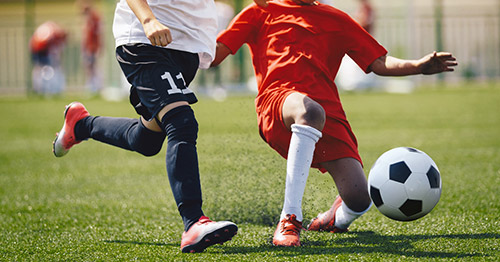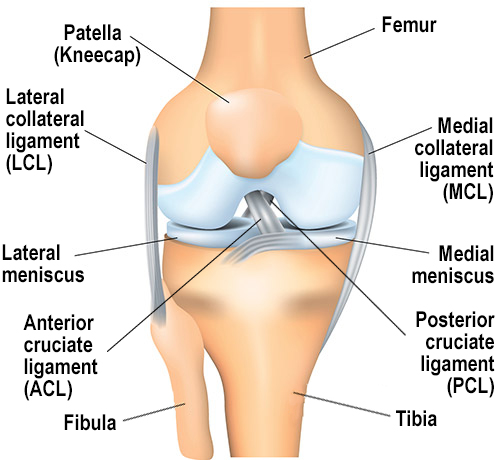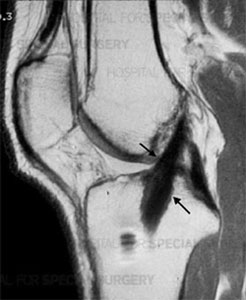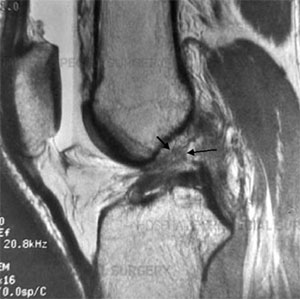ACL Tear (Torn ACL)
A complex set of tendons and ligaments help stabilize and support the knee joint with its every movement, from a simple walking step to an ice skater’s leap. Unfortunately, these tissues are vulnerable to injury. In particular, tears of the anterior cruciate ligament (ACL) are quite common among athletes and active individuals of all ages.


What is the ACL?
The anterior cruciate ligament (ACL) is one of four major ligaments in the knee joint. It helps maintain the knee's rotational stability and prevents the tibia (shinbone) from slipping in front of the femur (thighbone).
The ACL is particularly vulnerable to injury during athletic activity or as the result of impact, and a torn ACL is a common injury in athletes of all levels. It is especially common in sports with a lot of leg planting, cutting and pivoting, such as soccer, basketball, skiing and football. Surgery is often required when a person tears their ACL.
What is an ACL tear?
An ACL tear is when the anterior cruciate ligament becomes partially or completely ruptured. Once torn, an ACL cannot regrow or heal on its own.

Side-view MRI showing a healthy, intact ACL

Side-view MRI showing a completely torn ACL
Who tears their ACL?
People of all ages, physical conditions and abilities can tear an ACL. Active women experience a higher incidence of ACL injuries than men because their biomechanics tend to put more stress on their knees.
ACL injuries are also common in children, especially as youth sports become increasingly competitive. Until recently, ACL treatment for children and adolescents was exclusively nonsurgical. This was because traditional ACL surgery techniques could cause growing children to develop a leg length discrepancy or growth deformity. However, newer surgical techniques have made surgical repair an option for many kids and teens.
How do you tear your ACL?
A partial or complete ACL tear (rupture) often occurs during a sudden twisting movement, in which a person stops quickly and changes direction, especially while pivoting or landing after a jump.
A sudden, high-energy impact to the knee can also cause the ACL to tear. ACL tear injuries are often accompanied by injuries to other tissues in the knee, including cartilage (and, especially a torn meniscus) or additional knee ligaments, such as the MPFL.
Doing specific exercises, especially as part of a guided injury prevention program, can greatly reduce the chances of tearing your ACL.
Symptoms: What happens when the ACL is torn?
Common symptoms of a torn ACL include:
- popping sound at the time of injury
- pain
- swelling
- knee instability
When a person tears their ACL, they often report hearing a popping sound at the moment that the tear occurs. The knee will quickly swell and, in many cases, feel unstable. However, in some less severe tears, these symptoms may be mild. This is especially the case in people whose lifestyles do not involve intense physical activity.
If the ACL is completely torn, there will be instability in the knee that will cause feelings of sudden shifting or buckling. People will be unable to:
- jump and land on the knee
- accelerate and then change directions
- rapidly pivot on the knee
What should I do if I think I have torn my ACL?
Immediately after an ACL injury, it is important to:
- Stay off the leg and elevate it.
- Decrease the inflammation in the knee by:
- Applying ice.
- Taking nonsteroidal anti-inflammatory drugs (NSAIDs) such as ibuprofen.
- Consult an orthopedist or sports medicine physician as soon as possible.
The doctor will determine how bad the ACL injury is and review whether nonsurgical treatment and rehabilitation will be enough or if orthopedic surgery is necessary. Whether or not surgery is performed, physical therapy will be critical to strengthen the muscles surrounding the knee and improve its range of motion.
How is a torn ACL diagnosed?
A doctor can usually diagnose a torn ACL from a physical exam, although magnetic resonance imaging (MRI) is helpful. Getting an MRI is also important to find out if other parts of the knee have been injured.
Can ACL tears be treated nonsurgically?
Surgery is not necessary for all patients. The main conservative treatments are rest and anti-inflammatory medication to reduce pain and inflammation.
Some patients may also be fitted with a leg brace for use during activities that place stress on the knee. The doctor will also prescribe a course of physical therapy. This rehabilitation regimen is extremely important for preventing future injury.
Possible disadvantages of nonsurgical treatments
The long-term outcome for patients who are treated nonsurgically varies. Those who return to unrestricted activity are likely to experience some knee instability. Pain may be associated with the physical therapy regimen. In the absence of an intact ACL – even when no other injury is present – the menisci (pads of cartilage that cushion the bones that meet at the knee joint) have a higher risk of injury. If a meniscus tear forms in one or both menisci of the knee, pain and swelling may occur. More importantly, a damaged meniscus increases a patient's risk of developing osteoarthritis of the knee later in life.
When is ACL surgery necessary?
The choice to have surgery is usually based on the patient's lifestyle. In athletes and other people of any age who wish to continue doing physically demanding activity, an ACL reconstruction surgery is often needed.
If the injury is not too severe, some patients who do not need to perform intense athletics or physical labor may be able to go without surgery and still lead active, healthy lifestyles. Many people with torn ACLs who receive conservative, nonsurgical treatments are able to swim, jog and use most equipment found at the gym or health club.
When surgery is indicated, it is beneficial to have it within six months of the injury.
Articles for further reading
Below, explore articles and other content on ACL injuries or find a doctor or surgeon at HSS who treats ACL injuries to match your specific condition and insurance.
ACL injury overview articles
Read more discussions on ACL injuries.
ACL surgery articles
Learn about surgical treatments for ACL tears.
ACL injury prevention articles
Learn about performance exercises and other ways to help avoid tearing your ACL.
Articles on related conditions
Read information about related injuries and about the heightened risk of future osteoarthritis of the knee resulting from a torn ACL.
Related articles from HSS Move Better Feel Better
HSS Move Better Feel Better features tips on health, mind-body issues, fitness, and injury prevention for adults and children.
ACL Tear (Torn ACL) Success Stories
In the news
References
- Albright JC, Carpenter JE, Graf BK, et al. Knee and leg: soft tissue trauma. In: Orthopaedic Knowledge Update 6, Beaty JH (Ed), American Academy of Orthopaedic Surgeons, Rosemont 1999. p.533.
Musahl V, Karlsson J. Anterior Cruciate Ligament Tear. N Engl J Med. 2019;380(24):2341. - Forsythe B, Lu Y, Agarwalla A, Ezuma CO, Patel BH, Nwachukwu BU, Beletsky A, Chahla J, Kym CR, Yanke AB, Cole BJ, Bush-Joseph CA, Bach BR, Verma NN. Delaying ACL reconstruction beyond 6 months from injury impacts likelihood for clinically significant outcome improvement. Knee. 2021 Oct 30;33:290-297. doi: 10.1016/j.knee.2021.10.010. Epub ahead of print. PMID: 34739960.
- Gordon MD, Steiner ME. Anterior cruciate ligament injuries. In: Orthopaedic Knowledge Update Sports Medicine III, Garrick JG (Ed), American Academy of Orthopaedic Surgeons, Rosemont 2004. p.169.
- Halvorsen KC, Marx RG, Wolfe I, Taber C, Jivanelli B, Pearle AD, Ling DI. Higher Adherence to Anterior Cruciate Ligament Injury Prevention Programs Is Associated With Lower Injury Rates: A Meta-Analysis and Meta-Regression. HSS J. 2023 May;19(2):154-162. doi: 10.1177/15563316221140860. Epub 2022 Dec 13. PMID: 37065096; PMCID: PMC10090850.